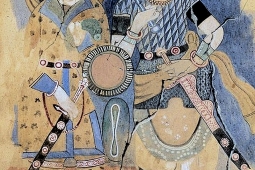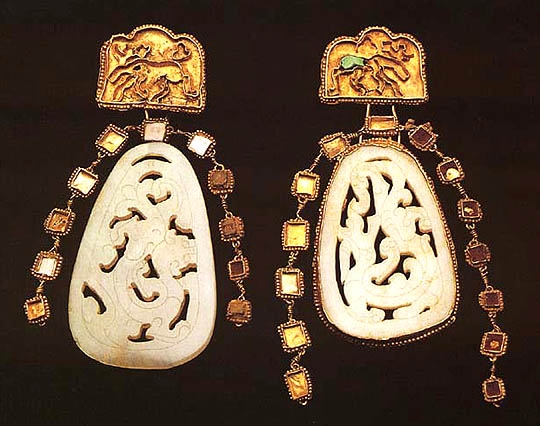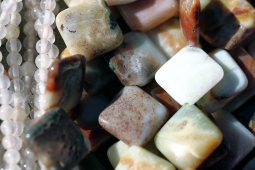Cultural Selection: Cross-Cultural Elements Evident in a Steppe Headdress and Earrings
© Julie LaurentThroughout the history of the Silk Roads, the people occupying the steppe and mountainous regions of Central and East Asia have been known for their high mobility and crucial role in some of the most intense interactions and rich exchanges occurring along these routes. For example, there is significant evidence for interactions between China and the people who occupied the neighbouring steppe from the earliest times. These rich interactions and influences were evidenced in a wide range of fields including gastronomy in the introduction of domesticated plants such as wheat, in mobility and travel in the introduction of horse drawn carts in Yin China (1600 – 1046 BCE), and across the arts in popular design motifs such as animal head engravings and carving, as well as in the transmission of decorated bronze mirrors.
Essential to much of this early exchange was an alliance of steppe peoples historians refer to as the Xiongnu, who occupied the region to the north of what was at the time the border of China from the 3rd century BCE onwards. Finds from excavations at archaeological sites and Xiongnu tombs on the Mongolian steppe, including Chinese silks, bronze mirrors, and lacquerware (objects covered in a decorative shiny finish or gloss) attest to the rich exchange these societies participated in. One particular object of note, which was uncovered from a site in the north-eastern edge of the Ordos plateau on the Yellow river in what is present day China, is a highly elaborate gold headdress accompanied with a pair of earrings excavated from within the grave of an elite woman. Recent scholarship has argued that some of these tombs at the site date from as far back as the late 1st century BCE - 1st century CE when this particular region was part of the Southern Xiongnu alliance. The headdress itself displays a distinctly cosmopolitan style incorporating components normally seen in similar objects made for the Chinese elite combined with ornamentation characteristic of the Xiongnu steppe. This hybridity is particularly apparent in the diverse materials used to construct it including glass and amber beads with jade pendants, gold foil and mother of pearl inlay. Parts of the headdress were made with worked gold, inlays of semi-precious stones, and oval pieces of carved jade in aesthetic styles that were evident in both these neighbouring cultures as well as others of East Asia.
The jade plaques which hang from the main headband of the headdress feature two dragon-like creatures, common motifs in similar art of the time, one in profile and the other face on. The gold for the inlaid stones was hammered into shape and decorated with beads of additional gold. This simple method of working the metal was used by both the settled populations in China and those of the steppe. It is not known for certain where the jade in the headdress would have been imported from but there are a few theories. In general nephrite, one of the two mineral species of jade, used in China at this time was often imported from Siberia and the Khotan regions including the Tarim Basin in Central Asia. It has therefore been suggested that some jade may also have been imported from these locations along with other natural resources. Furthermore, the headdress, with its jewelled headband and dangling golden elements, complex necklace, and accompanying earrings, is very similar in structure to a burial crown uncovered at a site in Tillya Tepe in Central Asia on the border between present-day Afghanistan and Turkmenistan. These similarities point towards the existence at this time of a distinctive cosmopolitan elite style which was shared across northern China, the steppe, and parts of Central Asia in a hybridised understanding of the ways social status could be conveyed artistically and through accessories.
Additionally, there is further speculation as to where exactly the headdress was made. The dark green plaques on the headdress are very similar in design and form to bronze belt plaques found at sites in Eastern Siberia. It also resembles gold plaques excavated from a tomb in Sidorovka near Omsk in western Siberia. These similarities, combined with the fact that communities of Chinese craftsmen were known to have worked at Ivolga near Ulan-Ude in modern day Russia, has led to the hypothesis that the dark green plaque parts of the headdress may have been made in this region and then potentially transported elsewhere. Much else remains unknown about this magnificent headdress and earrings, including for example whether or not it was ever intended to be worn or if it was purely decorative, where the many constituent parts were constructed and who made them. However, it is clear that it was buried with a woman of an elite social standing, whether or not it was made by craftsmen from China or the steppe or was an object of trade or a diplomatic gift, the elaborate headdress reflects and represents elements of both of these cultures who participated in considerable exchange across this section of the Silk Roads during a period of rich interaction in many spheres.
See Also

Chinese, Sogdian, and Byzantine Influences on Caftans Uncovered from Archaeological Sites along the Silk Roads
A caftan is a variant, or style, of robe which may be made of wool, cashmere, cotton, or silk and often bound with a sash. It can be worn as a coat or overdress down to the ankles, usually with long sleeves.








